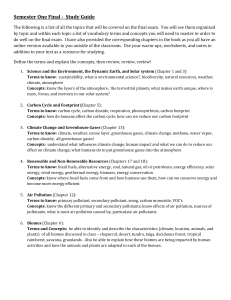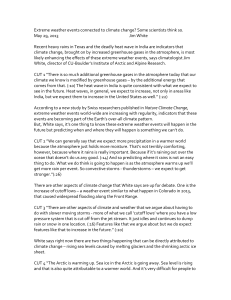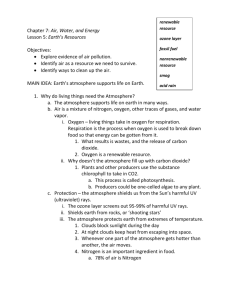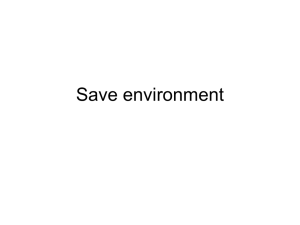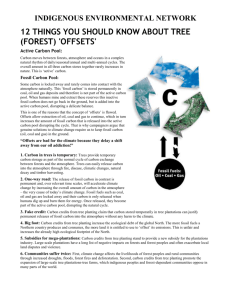fossil contamination
advertisement
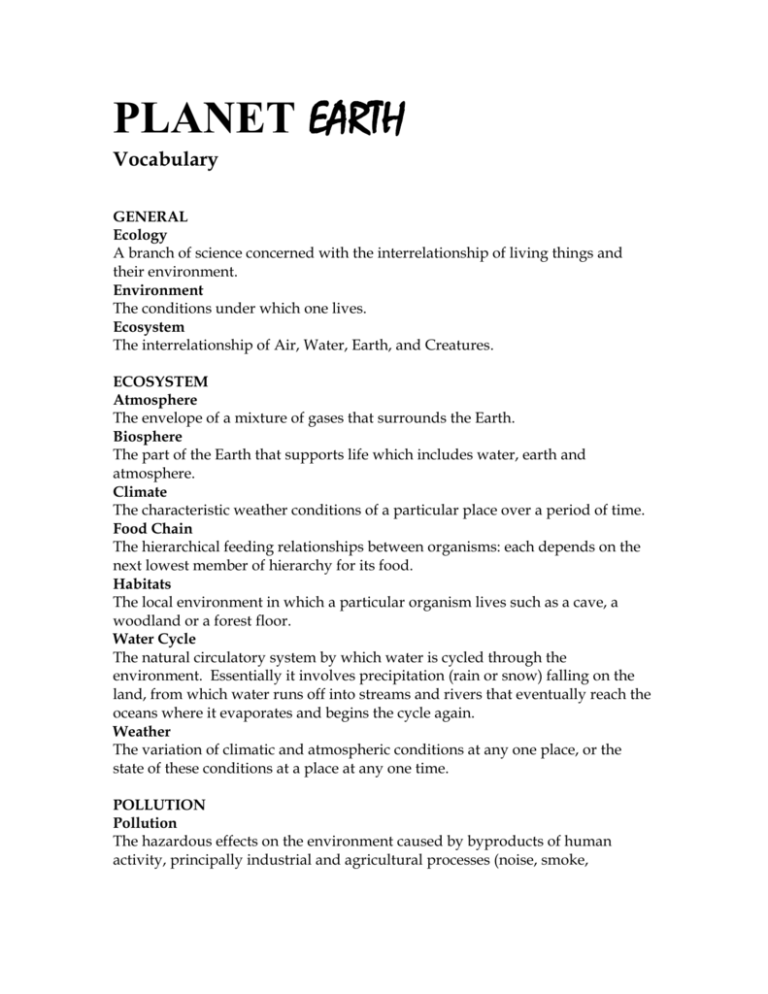
PLANET EARTH Vocabulary GENERAL Ecology A branch of science concerned with the interrelationship of living things and their environment. Environment The conditions under which one lives. Ecosystem The interrelationship of Air, Water, Earth, and Creatures. ECOSYSTEM Atmosphere The envelope of a mixture of gases that surrounds the Earth. Biosphere The part of the Earth that supports life which includes water, earth and atmosphere. Climate The characteristic weather conditions of a particular place over a period of time. Food Chain The hierarchical feeding relationships between organisms: each depends on the next lowest member of hierarchy for its food. Habitats The local environment in which a particular organism lives such as a cave, a woodland or a forest floor. Water Cycle The natural circulatory system by which water is cycled through the environment. Essentially it involves precipitation (rain or snow) falling on the land, from which water runs off into streams and rivers that eventually reach the oceans where it evaporates and begins the cycle again. Weather The variation of climatic and atmospheric conditions at any one place, or the state of these conditions at a place at any one time. POLLUTION Pollution The hazardous effects on the environment caused by byproducts of human activity, principally industrial and agricultural processes (noise, smoke, automobile emissions, chemical and radioactive effluents in air, seas and rivers, pesticides, radiation, sewage) and household waste. Accumulation The buildup of a persistent pesticide within the environment. Acid Rain Precipitation (including snow, sleet and fog as well as rain) of an acidity below about pH 4.5 - 5, principally due to the burning of fossil fuels and from automobile exhaust fumes into the atmosphere. In the atmosphere, these gases are converted into acids that fall as corrosive rain. Acid rain is linked with damage to and death of forests and lakes. Atmospheric Pollution Contamination of the atmosphere caused by the discharge of a wide range of toxic airborne substances. Chlorofluorocarbons A group of synthetic odorless, nontoxic, nonflammable and chemically inert gases containing chlorine, fluourine, carbon and sometimes hydrogen. Deforestation The permanent removal of forest and undergrowth; destruction of forest for timber, fuel, and clearing for agriculture and extraction industries, such as mining, without planting new trees or working on a cycle that allows the natural forest to regenerate. Endangered Species Any plant or animal whose numbers are so few that it is at risk of becoming extinct. Extinction The complete disappearance of a species. The current rate of extinction is difficult to estimate, because most losses occur in the tropical rainforest, where the total number of existing species is not known; but it is estimated to be one species per day. Global Warming The projected climate change attributed to excessive carbon dioxide in the atmosphere, which acts like a thermal blanket, preventing the escape of heat. Greenhouse Effect The increase in the temperature of the Earthís atmosphere caused by solar radiation, absorbed by and re-emitted from the Earthís surface, being prevented from escaping by various gases in the air. The main greenhouse gases are carbon dioxide (from the burning of fossil fuels and from forest fires), methane (mostly from agriculture) and chlorofluorocarbons (CFCs from aerosol cans). Fossil Fuel Any fuel, such as coal, oil and natural gas, derived from the fossilized remains of plants. Fossil fuels are a nonrenewable energy source. They also release carbon dioxide, thus causing its accumulation in the atmosphere. Extraction of coal and oil can cause environmental pollution, and burning coal contributes to problems of acid rain and the greenhouse effect. Habitat Loss The more or less permanent destruction of a habitat, usually as a result of the activities of humans, such as deforestation of tropical rainforests, and the removal of vegetation that leads to desertification. One consequence of habitat loss is the drastic reduction in the numbers of one or more species that may eventually result in their extinction. Overexploitation Exhausting natural resources by excessively heavy use --for example by excess cultivation or fishing. Overfishing The catching of fish at rates that exceed the capacity of the stock to replenish itself by reproduction, resulting in a decline in population. Smog Fog that contains impurities (such as unburned carbon and sulfur dioxide) derived from domestic fires, industrial furnaces, certain power stations, and petrol and diesel engines. Smog can cause illness and loss of life as well as damage to wildlife. Toxic Describing a substance that is poisonous or harmful to living organisms. SOLUTIONS Conservation The planning and management actions taken to protect and preserve the natural world, usually from pollution, overexploitation and other harmful features of human activity. Biodegradable Describing a substance that can be broken down by living organisms into its simpler substances. Biodiversity An overall measure of the variety of the Earthís animal, plant and microbial species of genetic differences within species, and of the ecosystems that support thoses species. Energy Efficiency Preserving energy resources by reducing the use of energy. Profligate and inefficient energy used by industrialized countries contributes greatly to atmospheric pollution and the greenhouse effect. Environmental Protection Agency A United States Government Agency whose mission is to protect human health and to safeguard the natural environment--air, water, and land--upon which life depends through a variety of programs and services. Gasohol A fuel for the internal combustion engine of car, consisting of gasoline with the addition of 10 to 20 percent alcohol. The alcohol is made by destructive distillation (heating in the absence of air) of wood--that is, the process is based on a renewable resource--rather than on nonrenewable fossil fuels. Organic Farming Farming without agrochemicals. Organic farming produces food with minimal residues and reduces pollution. It is labor intensive and therefore more expensive, but uses less fossil fuel. Preservation As more species become extinct each year, awareness has grown of the importance of preserving wildlife. Preserving diversity is best maintained in the wild by preserving habitats as well as creating gene pools, biodiversity, and reintroducing species to their original habitats. Recycling The processing of industrial and household waste (such as paper, glass, and some metals and plastics) so that it can be re-used, thus saving expenditure on scarce raw materials, slowing down the depletion of non renewable resources and helping to reduce pollution. Regeneration The natural renewing of growth that follows destruction, for example, forest regrowth after felling. Such forest regeneration is essential for the long-term stability of many resource systems. Renewable Energy Energy produced from any source that replenishes itself. Most renewable systems rely on solar energy directly or through the weather cycle as wave power for example. Restoration The practice of returning a habitat to its original state; for example, replanting hedgerows and woodland on land devastated by poor agricultural practice. Solar Energy The radiant energy from the Sun. Most of this energy is scattered or absorbed by the atmosphere and the remainder is used by plants for photosynthesis. This energy can also be harnessed and put to practical use as a source of heat or converted into electricity by photocells and solar panels. Solar energy has the great advantage of being both clean and renewable. Sustainability The concept of using resources to improve life on Earth without reducing the Earthís ability to support life into the future. Through sustainable production and conservation sustainability is a major goal of many environmental groups.
